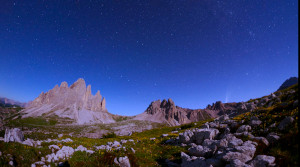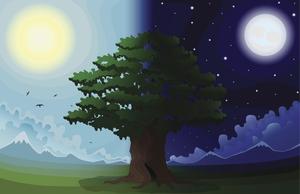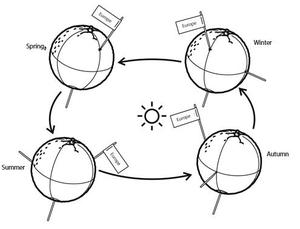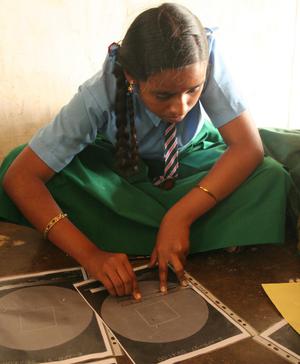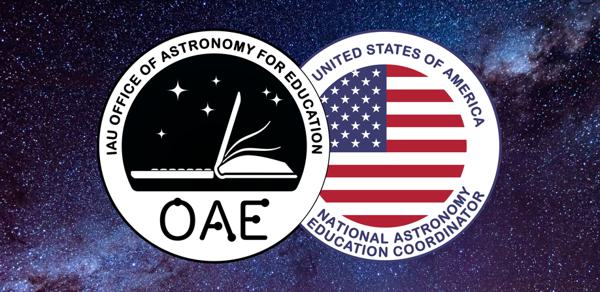Glossary term: Rotação
Description: Rotação é o movimento de um objeto em torno de uma linha imaginária, que é chamada de eixo de rotação. À medida que o objeto gira, cada uma de suas diferentes partes mantém exatamente a mesma distância do eixo de rotação. Em geral, as estrelas (inclusive o Sol), os planetas, as luas ou os asteroides giram em torno de um eixo fixo. A Terra gira em torno do eixo terrestre, que é a linha reta imaginária que passa pelos polos norte e sul da Terra. A rotação da Terra é responsável pela mudança na visão do céu noturno que todo observador que estiver na superfície da Terra verá, com novas estrelas surgindo continuamente no horizonte leste e se pondo no horizonte oeste. O fato de o Sol parecer se mover pelo céu durante o dia, nascendo no leste e se pondo no oeste, também é uma consequência da rotação da Terra.
Related Terms:
See this term in other languages
Term and definition status: The original definition of this term in English have been approved by a research astronomer and a teacher The translation of this term and its definition is still awaiting approval
The OAE Multilingual Glossary is a project of the IAU Office of Astronomy for Education (OAE) in collaboration with the IAU Office of Astronomy Outreach (OAO). The terms and definitions were chosen, written and reviewed by a collective effort from the OAE, the OAE Centers and Nodes, the OAE National Astronomy Education Coordinators (NAECs) and other volunteers. You can find a full list of credits here. All glossary terms and their definitions are released under a Creative Commons CC BY-4.0 license and should be credited to "IAU OAE".
If you notice a factual or translation error in this glossary term or definition then please get in touch.
Related Media
Big Dipper and Comet Neowise C2020 F3
Credit: Giorgia Hofer/IAU OAE (CC BY 4.0)
License: CC-BY-4.0 Creative Commons Attribution 4.0 International (CC BY 4.0) icons
Related Activities
Why Do We Have Day and Night?
astroEDU educational activity (links to astroEDU website) Description: Explore day and night of Earth.
License: CC-BY-4.0 Creative Commons Attribution 4.0 International (CC BY 4.0) icons
Tags:
Tilt
Age Ranges:
6-8
, 8-10
, 10-12
Education Level:
Primary
, Secondary
Areas of Learning:
Modelling
, Structured-inquiry learning
, Social Research
Costs:
Low Cost
Duration:
1 hour 30 mins
Group Size:
Group
Skills:
Asking questions
, Communicating information
Day and Night in the World
astroEDU educational activity (links to astroEDU website) Description: Compare diurnal and nocturnal animals and experiment with day and night.
License: CC-BY-4.0 Creative Commons Attribution 4.0 International (CC BY 4.0) icons
Tags:
Life
, Model
, Animals
, Day and night
Age Ranges:
6-8
, 8-10
Education Level:
Primary
Areas of Learning:
Interactive Lecture
, Modelling
, Social Research
Costs:
Low Cost
Duration:
1 hour
Group Size:
Group
Skills:
Asking questions
, Constructing explanations
, Developing and using models
, Planning and carrying out investigations
Seasons Around the World
astroEDU educational activity (links to astroEDU website) Description: Demonstrate the seasons on Earth using a model.
License: CC-BY-4.0 Creative Commons Attribution 4.0 International (CC BY 4.0) icons
Tags:
Hands-on
, Model
Age Ranges:
6-8
, 8-10
, 10-12
Education Level:
Middle School
, Primary
Areas of Learning:
Modelling
, Social Research
Costs:
Medium Cost
Duration:
45 mins
Group Size:
Group
Skills:
Analysing and interpreting data
, Asking questions
, Constructing explanations
, Developing and using models
, Planning and carrying out investigations
Measure the Sun's Rotation Period
astroEDU educational activity (links to astroEDU website) Description: Find out the Sun’s rotation period, applying the simple equation of average speed to a real astronomical case.
License: CC-BY-4.0 Creative Commons Attribution 4.0 International (CC BY 4.0) icons
Tags:
Hands-on
, History
, Experiment
, Galileo
, average speed
Age Ranges:
16-19
Education Level:
Secondary
Areas of Learning:
Social Research
Costs:
Low Cost
Duration:
1 hour 30 mins
Group Size:
Group
Skills:
Analysing and interpreting data
, Engaging in argument from evidence
, Planning and carrying out investigations
, Using mathematics and computational thinking
Is the Sun rotating? Follow the sunspots!
astroEDU educational activity (links to astroEDU website) Description: Like a "modern" Galileo, use true astronomical satellite observations to discover if the Sun (and other celestial objects) are rotating!
License: CC-BY-4.0 Creative Commons Attribution 4.0 International (CC BY 4.0) icons
Tags:
Hands-on
, History
, Experiment
, Galileo
Age Ranges:
12-14
, 14-16
, 16-19
Education Level:
Middle School
, Secondary
Areas of Learning:
Social Research
Costs:
Low Cost
Duration:
1 hour
Group Size:
Group
Skills:
Analysing and interpreting data
, Planning and carrying out investigations
